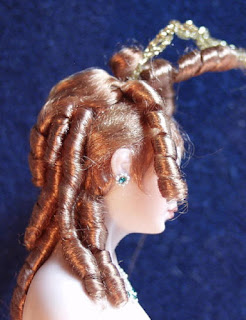 Don’t let digital kilns
scare you away! Their complex programming
capabilities seem intimidating to the first time
doll artist, but do not fret. They are actually a
lot more user friendly than you may think. The
firing process will become a lot easier once you get
past the first few firings. The wonderful thing
about digital kilns is their ease of use. They are
able to retain segment programs of your choosing
until you decide to change them. You are able to
program things such as heating speed, maximum
temperature in a specific segment, and the time it
will hold at that segment. Most digital controllers
come pre-programmed with firing schedules for a
variety of different projects. If you do choose to
customize your own program firing, the controller
can store many different your personalized programs
that you’ve formulated. With this feature, you don’t
need to worry about recreating firing schedules for
a project you plan on doing more than once. You can
set your most commonly used firing schedule at
Program 1 (PROG 1) and your second most common
firing schedule at Program 2 (PROG 2).
Don’t let digital kilns
scare you away! Their complex programming
capabilities seem intimidating to the first time
doll artist, but do not fret. They are actually a
lot more user friendly than you may think. The
firing process will become a lot easier once you get
past the first few firings. The wonderful thing
about digital kilns is their ease of use. They are
able to retain segment programs of your choosing
until you decide to change them. You are able to
program things such as heating speed, maximum
temperature in a specific segment, and the time it
will hold at that segment. Most digital controllers
come pre-programmed with firing schedules for a
variety of different projects. If you do choose to
customize your own program firing, the controller
can store many different your personalized programs
that you’ve formulated. With this feature, you don’t
need to worry about recreating firing schedules for
a project you plan on doing more than once. You can
set your most commonly used firing schedule at
Program 1 (PROG 1) and your second most common
firing schedule at Program 2 (PROG 2).Some symbols that you will need to know are RA (Rate per hour), TEMP (temperature you want the kiln to get to in that segment), HLD (time you would like the kiln to hold at that temperature), PROG (program), and STRT (start). Once you press start, you will hear the kiln begin to click, which is completely normal.
 Certain factors, such
as brand, kiln model, age of kiln, and location
all affect the way your kiln will fire. All kilns
fire differently and certain temperatures may need
to be adjusted, so experimenting with different
firing programs is a great way to start. Try
firing some “mess –up” bisque pieces for these
experiment firings, just so that you can get a
feel for which program yields the best results for
you without ruining your good bisque in case the
kiln over-fires. Sometimes firing at a true Cone 6
can be too hot and you may end up with over-fired
pieces (indicated by little white dots on the
porcelain). In this case, try firing to Cone 5 or
Cone 4 and see if this changes the results. If
your porcelain is under-fired, try adding a hold
to the next firing. This should correct the
under-firing. However, use holds with caution
because it can easily over-fire the bisque if you accidentally enter 2 hours (02.00) instead of 20
minutes (00.20) of hold time. Experimenting at the
beginning really helps the first time kiln user
with establishing a good firing schedule.
Certain factors, such
as brand, kiln model, age of kiln, and location
all affect the way your kiln will fire. All kilns
fire differently and certain temperatures may need
to be adjusted, so experimenting with different
firing programs is a great way to start. Try
firing some “mess –up” bisque pieces for these
experiment firings, just so that you can get a
feel for which program yields the best results for
you without ruining your good bisque in case the
kiln over-fires. Sometimes firing at a true Cone 6
can be too hot and you may end up with over-fired
pieces (indicated by little white dots on the
porcelain). In this case, try firing to Cone 5 or
Cone 4 and see if this changes the results. If
your porcelain is under-fired, try adding a hold
to the next firing. This should correct the
under-firing. However, use holds with caution
because it can easily over-fire the bisque if you accidentally enter 2 hours (02.00) instead of 20
minutes (00.20) of hold time. Experimenting at the
beginning really helps the first time kiln user
with establishing a good firing schedule.There are many advantages of digital kilns:
·
-They offer a
variety of tools that provide you with more
information, more accurate temperatures, and
solutions for fixing various problems that may
arise in the kiln
·
-They are
able to better inform you before and during the
firing process
·
-Give you the
freedom to go about your day instead of constantly
monitoring your kiln for multiple hours
·
-More user
control with setting customized programs
·
-More
consistent results
·
-Peace of
mind knowing that your firing will go exactly how
you programmed it to, every time












































